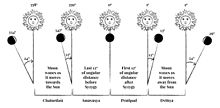New moon
This article has multiple issues. Please help improve it or discuss these issues on the talk page. (Learn how and when to remove these messages)
|


In astronomy, the new moon is the first lunar phase, when the Moon and Sun have the same ecliptic longitude.[2] At this phase, the lunar disk is not visible to the naked eye, except when it is silhouetted against the Sun during a solar eclipse.
The original meaning of the term 'new moon', which is still sometimes used in calendrical, non-astronomical contexts, is the first visible crescent of the Moon after conjunction with the Sun.[3] This thin waxing crescent is briefly and faintly visible as the Moon gets lower in the western sky after sunset. The precise time and even the date of the appearance of the new moon by this definition will be influenced by the geographical location of the observer. The first crescent marks the beginning of the month in the Islamic calendar[4] and in some lunisolar calendars such as the Hebrew calendar. In the Chinese calendar, the beginning of the month is marked by the last visible crescent of a waning Moon.
The astronomical new moon occurs by definition at the moment of conjunction in ecliptical longitude with the Sun when the Moon is invisible from the Earth. This moment is unique and does not depend on location, and in certain circumstances, it coincides with a solar eclipse.
A lunation, or synodic month, is the period from one new moon to the next. At the J2000.0 epoch, the average length of a lunation is 29.53059 days (or 29 days, 12 hours, 44 minutes, and 3 seconds).[5] However, the length of any one synodic month can vary from 29.26 to 29.80 days (12.96 hours) due to the perturbing effects of the Sun's gravity on the Moon's eccentric orbit.[6]
Lunation number
[edit]This section needs additional citations for verification. (May 2015) |
The Lunation Number or Lunation Cycle is a number given to each lunation beginning from a specific one in history. Several conventions are in use.
The most commonly used was the Brown Lunation Number (BLN), which defines "lunation 1" as beginning at the first new moon of 1923, the year when Ernest William Brown's lunar theory was introduced in the American Ephemeris and Nautical Almanac. [citation needed] Lunation 1 occurred at approximately 02:41 UTC, 17 January 1923. With later refinements, the BLN was used in almanacs until 1983.[7]
A more recent lunation number (called the Lunation Number) was introduced by Jean Meeus in 1998.[8] defines lunation 0 as beginning on the first new moon of 2000 (this occurred at approximately 18:14 UTC, 6 January 2000). The formula relating Meeus's Lunation Number with the Brown Lunation Number is BLN = LN + 953.
The Goldstine Lunation Number refers to the lunation numbering used by Herman Goldstine,[9] with lunation 0 beginning on 11 January 1001 BCE, and can be calculated using GLN = LN + 37105.
The Hebrew Lunation Number is the count of lunations in the Hebrew calendar with lunation 1 beginning on 6 October 3761 BCE.[10] It can be calculated using HLN = LN + 71234.
The Islamic Lunation Number is the count of lunations in the Islamic Calendar with lunation 1 as beginning on the first day of the month of Muharram, which occurred in 622 CE (15 July, Julian, in the proleptic reckoning).[11] It can be calculated using ILN = LN + 17038.
The Thai Lunation Number is called "มาสเกณฑ์" (Maasa-Kendha), defines lunation 0 as the beginning of Burmese era of the Buddhist calendar on Sunday, 22 March 638 CE.[citation needed] It can be calculated using TLN = LN + 16843.
Lunisolar calendars
[edit]Hebrew calendar
[edit]The new moon, in Hebrew Rosh Chodesh, signifies the start of every Hebrew month and is considered an important date and minor holiday in the Hebrew calendar. The modern form of the calendar practiced in Judaism is a rule-based lunisolar calendar, akin to the Chinese calendar, measuring months defined in lunar cycles as well as years measured in solar cycles, and distinct from the purely lunar Islamic calendar and the predominantly solar Gregorian calendar. The Jewish months are fixed to the annual seasons by setting the new moon of Aviv, the barley ripening, or spring, as the first moon and head of the year.[12] Since the Babylonian captivity, this month is called Nisan, and it is calculated based on mathematical rules designed to ensure that festivals are observed in their traditional season. Passover always falls in the springtime.[13] This fixed lunisolar calendar follows rules introduced by Hillel II and refined until the ninth century. This calculation makes use of a mean lunation length used by Ptolemy and handed down from Babylonians, which is still very accurate: ca. 29.530594 days vs. a present value (see below) of 29.530589 days. This difference of only 0.000005, or five millionths of a day, adds up to about only four hours since Babylonian times.[citation needed]
Chinese calendar
[edit]The new moon is the beginning of the month in the Chinese calendar. Some Buddhist Chinese keep a vegetarian diet on the new moon and full moon each month.[14]
Hindu calendar
[edit]
The new moon is significant in the lunar Hindu calendar. The first day of the calendar starts the day after the dark moon phase (Amavasya).[15]
There are fifteen moon dates for each of the waxing and waning periods. These fifteen dates are divided evenly into five categories: Nanda, Bhadra', Jaya, Rikta, and Purna, which are cycled through in that order.[16] Nanda dates are considered to be favorable for auspicious works; Bhadra dates for works related to community, social, family, and friends; and Jaya dates for dealing with conflict. Rikta dates are considered beneficial only for works related to cruelty. Purna dates are considered to be favorable for all work.[16]: 25
This section is empty. You can help by adding to it. (March 2021) |
Lunar calendars
[edit]Islamic calendar
[edit]The lunar Hijri calendar has exactly 12 lunar months in a year of 354 or 355 days.[17] It has retained an observational definition of the new moon, marking the new month when the first crescent moon is seen, and making it impossible to be certain in advance of when a specific month will begin (in particular, the exact date on which the month of Ramadan will begin is not known in advance). In Saudi Arabia, the new King Abdullah Centre for Crescent Observations and Astronomy in Mecca has a clock for addressing this as an international scientific project. [citation needed] In Pakistan, there is a "Central Ruet-e-Hilal Committee" whose head is Mufti Muneeb-ur-Rehman, assisted by 150 observatories of the Pakistan Meteorological Department, which announces the sighting of the new moon.[18]
An attempt to unify Muslims on a scientifically calculated worldwide calendar was adopted by both the Fiqh Council of North America and the European Council for Fatwa and Research in 2007. The new calculation requires that conjunction must occur before sunset in Mecca, Saudi Arabia, and that, on the same evening, the moonset must take place after sunset. These can be precisely calculated and therefore a unified calendar is possible should it become adopted worldwide.[19][20]
Solar calendars holding moveable feasts
[edit]Baháʼí calendar
[edit]The Baháʼí calendar is a solar calendar with certain new moons observed as moveable feasts. In the Baháʼí Faith, effective from 2015 onwards, the "Twin Holy Birthdays", refer to two successive holy days in the Baháʼí calendar (the birth of the Báb and the birth of Bahá'u'lláh), will be observed on the first and the second day following the occurrence of the eighth new moon after Naw-Rúz (Baháʼí New Year), as determined in advance by astronomical tables using Tehran as the point of reference.[21] This will result in the observance of the Twin Birthdays moving, year to year, from mid-October to mid-November according to the Gregorian calendar.[22]
Christian liturgical calendar
[edit]Easter, the most important feast in the Christian liturgical calendar, is a movable feast. The date of Easter is determined by reference to the ecclesiastical full moon, which, being historically difficult to determine with precision, is defined as being fourteen days after the (first crescent) new moon.[23][24]
See also
[edit]Notes
[edit]- ^ Planetlight, zodiacal light, and starlight contribute a negligible amount of the total light that the lunar surface reflects.
References
[edit]- ^ "New Moon". Flickr. NASA/GSFC. 15 June 2011.
- ^ Meeus 1991, p. 319.
- ^ "new moon". Oxford English Dictionary (Online ed.). Oxford University Press. (Subscription or participating institution membership required.)
- ^ Islamic Crescents' Observation Project, Visibility of Muharram Crescent 1432 AH Archived 10 May 2012 at the Wayback Machine; seen on 6 December in Algeria, Iran, Saudi Arabia, South Africa.
- ^ Seidelmann 1992, p. 576.
- ^ Espenak, Fred. "Eclipses and the Moon's Orbit". NASA Eclipse Web Site. NASA. Retrieved 11 December 2016.
- ^ Chapront-Touzé, M; Chapront, J (2002). "Analytical Ephemerides of the Moon in the 20th Century" (PDF). Observatoire de Paris. pp. 21–22.
- ^ Meeus, Jean (1998). Astronomical algorithms (2nd ed.). Richmond, Va.: Willmann-Bell. ISBN 9780943396613. OCLC 40521322.
- ^ Goldstine, Herman (1973). New and Full Moons: 1001 B.C. to A.D. 1651. Philadelphia: American Philosophical Society. ISBN 9780871690944. OCLC 609368.
- ^ "Hebrew Calendar Calculator". webspace.science.uu.nl. Retrieved 2023-02-07.
- ^ Ilyas, M. (1991-06-01). "Hijrah Day Number, Islamic Day Number and Islamic Lunation Number: New parameters for exacting the Islamic calendar". Journal of the British Astronomical Association. 101: 175–176. Bibcode:1991JBAA..101..175I. ISSN 0007-0297.
- ^ Exodus 12:1–2
- ^ Posner, Menachem (2016). "How Does the Spring Equinox Relate to the Timing of Passover?". Chabad. Retrieved 9 December 2016.
- ^ "A Buddhist Perspective on Fasting". urbandharma.org. Retrieved 2016-09-18.
- ^ Long, Jeffery D. (9 September 2011). Historical Dictionary of Hinduism. Scarecrow Press. pp. 76–77. ISBN 978-0-8108-7960-7.
- ^ a b Wilhelm, Ernst (2003). Classical Muhurta. Kala Occult Publishers. pp. 23–25. ISBN 978-0-9709636-2-8. Retrieved 4 June 2022.
- ^ Seidelmann 1992, pp. 577.
- ^ "Senate body decides to draft Ruet-e-Hilal Constitution".
- ^ Fiqh Council of North America Decision: "Astronomical Calculations and Ramadan Archived 2010-08-28 at the Wayback Machine"
- ^ Islamic Society of North America Decision:"Revised ISNA Ramadan and Eid Announcement Archived 2007-11-11 at the Wayback Machine"
- ^ Momen, Moojan (2014). The Badí` (Baháʼí) Calendar: An Introduction Archived 2015-01-11 at the Wayback Machine.
- ^ The Universal House of Justice (2014-07-10). "To the Baháʼís of the World". Retrieved 2015-01-01.
- ^ Mosshammer 2008, p. 76: "Theoretically, the epact 30=0 represents the new moon in conjunction with the sun. The epact of 1 represents the theoretical first visibility of the moon's first crescent. It is from that point as day one that the fourteenth day of the moon is counted."
- ^ Dershowitz & Reingold 2008, pp. 114–115.
Works cited
[edit]- Dershowitz, Nachum; Reingold, Edward M. (2008). Calendrical Calculations. Cambridge University Press. ISBN 978-0-521-88540-9.
- Meeus, Jean (1991). Astronomical Algorithms. Willmann-Bell. ISBN 978-0-943396-35-4.
- Mosshammer, Alden A. (2008). The Easter Computus and the Origins of the Christian Era. Oxford University Press. ISBN 978-0-19-954312-0.
- Seidelmann, P. Kenneth, ed. (1992). Explanatory Supplement to the Astronomical Almanac. University Science Books. ISBN 978-0-935702-68-2.
External links
[edit]- Moon Watch site (Archived 2011-03-03 at the Wayback Machine) of the Nautical Almanac Office

